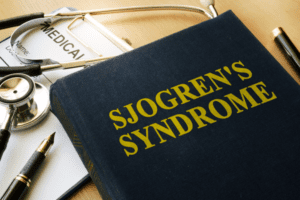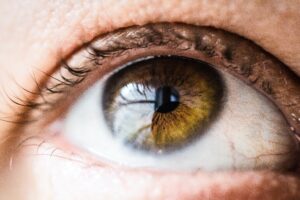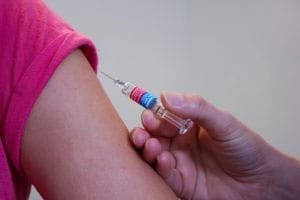Sjögren’s Syndrome
What is Sjögren’s syndrome?
Sjögren’s (pronounced “SHOW-grins”) syndrome was named for the Swedish ophthalmologist, Henrik Sjögren, who first described its symptoms in the 1900s. He noticed that a group of his female patients who had chronic arthritis also experienced dry eyes and mouths. Today, we know that Sjögren’s syndrome is an autoimmune disease, in which the body’s immune system, which normally helps protect you from disease and infection, mistakenly attacks healthy cells in the body’s moisture-producing glands—particularly those that produce tears (lacrimal glands) and saliva (salivary glands). However, Sjögren’s syndrome can affect many different parts of the body, including the kidneys, blood vessels, lungs, liver, pancreas, and brain.
Between 400,000 and 3.1 million adults have Sjögren’s syndrome. It can affect people of any ethnicity, age, and sex, but it affects 10 times as many women than men. Sjögren’s symptoms usually appear between the ages of 45 and 55, and it is rare for Sjögren’s syndrome to be diagnosed in children.
Sjögren’s syndrome is classified as either primary or secondary, and the two occur with about equal frequency.
- Primary Sjögren’s occurs in people with no other rheumatic disease and causes early decreased function in the lacrimal and salivary glands that progresses gradually
- Secondary Sjögren’s occurs in people who already have another autoimmune connective tissue disease, most commonly rheumatoid arthritis (RA) or systemic lupus erythematous (SLE, or “lupus”); these people then develop dry eyes or dry mouth.
What causes Sjögren’s syndrome?
The cause of Sjögren’s syndrome is unknown, but researchers think that a combination of genetic and environmental factors may play a role. Several different genes appear to be involved, but scientists are not exactly sure which ones are linked to the disease because different genes seem to play a different role in different people.
In addition, simply having one of these genes will not cause a person to develop the disease. Some sort of trigger—maybe a virus or an infection—must activate the immune system. But as of yet, no one knows what the triggers are for sure. The possibility that the endocrine and nervous systems play a role in Sjögren’s syndrome is also being investigated.
What are the symptoms of Sjögren’s syndrome?
- Irritation, gritty feeling, or painful burning in the eyes
- Increased risk of infections around the eye and damage to the cornea
- Dry mouth
- Difficulty talking, chewing, or swallowing
- Dry, peeling lips
- Change in taste or smell
- Increased dental decay and/or gum inflammation (gingivitis)
- Swelling of the glands around the face and neck
- Joint pain and stiffness
- Dryness in the nasal passages, throat, vagina, and skin
- Acid reflux
- Prolonged fatigue interfering with daily life
- Issues with cognition (headaches, brain fog, memory loss)
- Interstitial lung disease
- Bronchitis
- Pneumonia
- Liver disorders, such as primary biliary cholangitis or autoimmune hepatitis
- Peripheral neuropathy
- Gastrointestinal abnormalities (autoimmune pancreatitis, gastroparesis)
- Interstitial cystitis
- Interstitial nephritis
- Glomerulonephritis
- Irritable bowel syndrome
How is Sjögren’s syndrome diagnosed?
Many of the early symptoms of Sjögren’s syndrome may also be caused by other conditions, so diagnosis requires a physical examination, detailed discussion of symptoms, blood tests (including those used to determine the presence of certain antibodies), and sometimes special tests that assess any decrease in tear or saliva production. In some cases, biopsies of the saliva glands around the face or under the surface of the inner lip may be used.
What treatment options are available for Sjögren’s syndrome?
Currently, there is no cure for Sjögren’s syndrome, so treatment is generally focused on lessening the symptoms that are most bothersome. Artificial tears, and eye drops that reduce inflammation in the glands around the eyes, are often used. Drinking water, chewing gum, or using saliva substitutes or prescription medications that stimulate saliva flow may be used to relieve dry mouth. Nonsteroidal anti-inflammatory drugs (NSAIDS) may be used to ease joint pain and inflammation. For people with severe complications, corticosteroids or immunosuppressive drugs may be prescribed.
Where can I find more information about Sjögren’s syndrome?
Sjögren’s Syndrome Articles

Novartis Unveils Promising Phase III Data for Ianalumab in Sjögren’s Disease at ACR Convergence

Enrollment Completed in Clinical Trials for Primary Sjögren’s Syndrome and IgA Nephropathy


ACR Convergence 2023: New Data Shared on Dazodalibep for Sjögren’s Syndrome

Sjögren’s Syndrome Now Considered 2nd Most Common Autoimmune Condition

CoVER Study Seeks to Understand COVID-19 Vaccine Impact on Autoimmune Diseases






